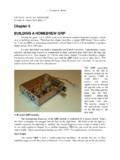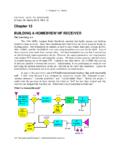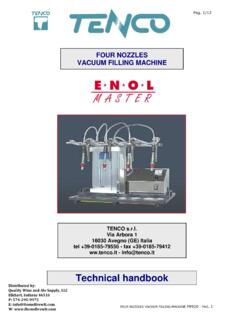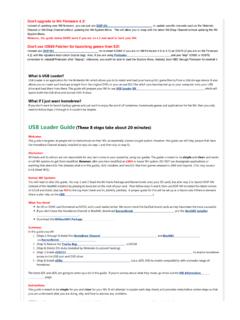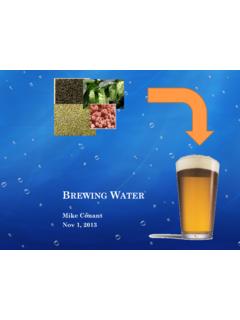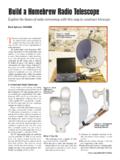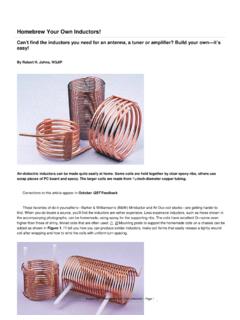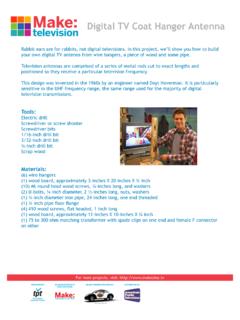Transcription of A Homebrew Yagi for 1296 MHz DX - OK2KKW connection
1 DUBUS 1/2006 16A Homebrew yagi for 1296 MHz DX by Heinrich F. Reckemeyer, DJ9YW - Many 23cm yagis from well known manufacturers are on the market. Anyway DXers want to know everything intimately. The author who works successfully via EME on this band wants to describe his own yagi design and give some of hints for the construction. At the beginning there was the idea to enlarge the active surface of my 1296 MHz antenna. For this purpose the long lasting single yagi should be substituted by a group of four yagis. In order to obtain real data for the gain I purchased yagis from different manufacturers and measured them several times under dry and wet conditions in free space and under conditions of little reflection.
2 Table 1 shows the results. Manufacturer model elements length [m] gain, dry [dBd] gain, wet [dBd] Hersteller Typ Elemente L nge ca. Gewinn, trocken Gewinn, nass M2 23CM35EZ 35 3 16,8 14,1 Tonna 20635 35 3 17,7 17,4 DJ9BV [1] 13WL 37 3 17,6 17,8 FlexaYagi 2317 48 4 17,8 15,4 SHF Design 2344 44 3 18,0 17,8 DJ9YW 4 m / 4 mm 47 4 18,7 18,6 DJ9YW 4 m / 3,2 mm 47 4 18,9 18,8 DJ9YW 5 m / 4 mm 59 5 19,7 19,6 Table/Tabelle 1.
3 Far field measurements at 1296 MHz - Fernfeldvergleichsmessungen bei 1296 MHz Interesting gain results The cheap Tonna yagi worked unexpectedly well, but due to the lack of a balun there is no clean matching and for my purposes the antenna was to heavy. The mounting of the elements is electrically well solved. The solution from the Flexa yagi could not be really understood due to the labile contact of different kinds of metal. Due to the steel elements und their by comparison small diameter this antenna would need to be 1m longer to be equal with the others. Wetness caused a strong gain drop. The M2 was completely off-beat. I guess that despite the claim of 1296 MHz as operating frequency the real strength may be in the lower part of the 23cm band.
4 The antenna from SHF Design (now WiMo) showed good gain but had quite a wind load due to the large reflector. Also critical is the lock of the elements. If the screws are not firmly tightened this could cause a loss in gain. The latter was probably solved best by the firm wrapping of the elements as done in the quite similar DUBUS yagi design from DL6WU/DJ9BV [1]. Fig. 1: Schema 10 element yagi Fig. 2: Parts for the dipole; bottom: a piece of UT141-CU for the balun DUBUS 1/2006 17 Months of work As none of the versions satisfied me I could not find a fast solution and started my own design by building countless prototypes and making gain measurements in free space.
5 At that time I had no antenna simulation software available. Unfortunately I did not know in advance how much time I had to spent for the development. But now the data for the design are determined and because of the large interest I want to share the possibility for building this yagi with other interested SHF friends. I have started with the 10 element version shown in Fig. 1. For the boom an aluminium profile of 15 x 15 mm and 2mm thickness was used. For the elements rods of AlMg5 with 4mm diameter were used. These were cut accurately to a tenth of a millimetre by a lathe. For the drilling I have made a moulding tool and firstly drilled with 3mm followed by Now the elements were driven in cleanly by a brass bush that was drilled to A centric hub is most important.
6 Building the dipole is more complex, see Fig. 2, 3 and 7. The inner conductor of diameter from Aircom Plus coaxial cable can be well used for this. The center of the dipole is grounded in order to prevent the expensive FETs of the RX and preamp, which are mostly coupled only by a 50 V SMD capacitor, from damage due to pulses. The coat of a waterproof N norm jack [2] is fixed with a bracket and M3 V2A screws to the boom. At it also the balun from semi rigid cable UT141-CU alias SR3 [3] is soldered. A cap from ABS [4] that is open downward provides protection from rain. Foaming in pack causes losses. An open mounting effects self drying. The dipole wire is bent over a roller on both sides to get 20 mm of internal distance.
7 The outer distance should be 121mm. Afterwards one can protect the complete dipole against corrosion with urethane spray [4]. Fig. 3: Assembling the balun at the N jack Fig. 4: Sweeping the 47 element yagi - Montage des Baluns an der N-Buchse max. gain at 1299 MHz - Wobbelkurve der 47-Element- yagi , Gewinnmaximum bei 1299 MHz The free space sweeping curve brings all to light After the 10 element yagi I started to design a 47 element yagi with a 4m boom of also 15 x 15 x 2mm. This one should be used for a stacked group of four yagis and also as a single yagi for portable operation from the car.
8 But one can not, as one can often read, simply extend the short yagi . The new length causes a frequency shift. Thus a completely new design was necessary. I have set the gain maximum to about 1299 MHz as shown in Fig. 4. Then the unavoidable frequency shift down due to wetness effects only marginal drops at 1296 MHz. This is of great practical importance because often when there is wet fog there are good tropo conditions. Later on I have got antenna simulation software for checking the results. Anyway after often more than 3 hours of processing time no program could deliver reliable data in the optimisation mode. In part I have got total crazy dimensions for the elements unless the presettings were already close to my determined values according table 3.
9 Personally I think the freely available program MMAna was the best [5]. Bodo, DL3 OCH, got the possibility to simulate my data with the professional software Microwave Studio and he provided the diagrams shown in Fig. 5 and Fig. 6. My measured results were widely confirmed. As the 4m version was working perfectly in practice and also the return loss was with more than 25 dB, I developed from this yagi another 5m long yagi with 59 elements and a clamp for elevation especially for EME work with WSJT [6] on 1296 MHz. See Fig. 8. The extension by 12 additional elements was not DUBUS 1/2006 18critical at the equal boom profile. Anyway an extension of the support boom made sense because of mechanical reasons.
10 The sagging of the boom should not exceed 3cm on both ends. This is the reason why the lightweight Aircom Plus cable was used as feedline. In the meantime several successful contacts took place via the moon with the dBD yagi and 100 w at the dipole [7], [8]. For portable use a quadripartite pluggable version has proved to be appropriate. Details for the pluggable connection are shown in Fig. 9. Due to the higher strain when transporting by a car it is recommended to lock the elements through the boom additionally with sharp self-tapping V2A screws. Fig. 5: Simulation of the 10 element yagi Fig. 6: Simulation of the 47 element yagi shows dBi gain and 41,2 horiz. aperture shows dBi gain ( dBD) and - Die Simulation der 10-Element- yagi 16,2 horizontal aperture Dito f r die weist 13,8 dBi Gewinn und 41,2 horizontalen 47 Ele.

